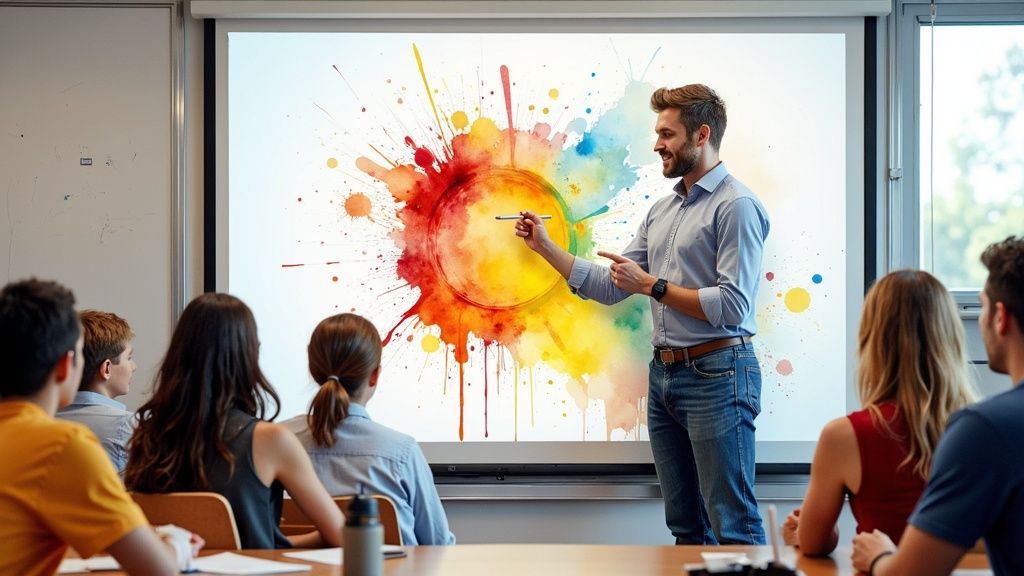10 Proven Student Engagement Strategies That Transform Learning
February 12, 2025

The Current State of Student Engagement

Modern classrooms present unique challenges when it comes to keeping students involved and interested. Simply being present isn't enough - real engagement requires active participation and genuine interest from students. To create effective teaching strategies, we need to understand how students engage with learning across different settings.
Varying Engagement Levels and Their Impact
Each classroom has its own unique energy and dynamic. Some buzz with enthusiasm and participation, while others struggle to keep students focused. The teaching approach and classroom environment make a big difference in how involved students become. When students are truly engaged, they develop better critical thinking abilities and remember what they learn more effectively.
Recent research by Kami reveals some interesting patterns. Their survey of over 3,000 teachers found that 53% of K-12 classrooms report strong student engagement. However, 43% see only moderate engagement levels, and 4% struggle with low participation. These numbers show there's still work to be done to get more students actively involved in learning.
Factors Influencing Student Participation
Many elements affect how engaged students feel in class. The connection between teachers and students plays a huge role - when students feel comfortable with their teacher, they're more likely to participate. Teaching style matters too. Traditional lectures often lead to passive learning, while hands-on projects tend to spark more interest. Student motivation also depends on what's happening both in and outside the classroom.
Adapting Strategies to Meet Evolving Needs
Understanding these factors helps teachers develop better ways to engage their students. Smart educators know that one teaching method won't work for everyone. Instead, they:
- Create personalized learning experiences
- Mix up their teaching methods
- Build positive classroom environments
- Help students feel valued and heard
When teachers stay flexible and try different approaches, they can better support each student's unique learning style. This naturally leads us to look at how engagement directly affects academic performance.
Understanding the Impact of Engagement on Academic Success
When students truly connect with their learning, something remarkable happens. They stop being passive recipients and become active participants in their education. This deep involvement shapes not just their academic performance, but their entire approach to learning.
The Long-Term Effects of Engagement
Students who are fully involved in their learning develop valuable skills that last well beyond the classroom. They build stronger critical thinking abilities, learn to process information more deeply, and retain knowledge better. Most importantly, they gain practical experience working with others - a skill that proves essential in their future careers.
Research backs this up convincingly. According to a Gallup Poll cited by STEM Sports, engaged students are 2.5 times more likely to excel academically and feel 4.5 times more optimistic about their future. These numbers show just how much engagement matters for both school success and personal growth.
Making Classrooms Come Alive
Teachers who switch from traditional lectures to hands-on learning see their students flourish. Project-based activities, educational games, and real-world problem solving get students excited about learning. Want to learn more? Check out these proven classroom engagement strategies.
Going Beyond Just Showing Up
Real engagement means more than just being present - it's about creating an environment where students want to learn. When students are truly engaged, they develop essential skills like teamwork, clear communication, and creative problem-solving. Most importantly, they discover the joy of learning that can last a lifetime.
Using Data Analytics for Personalized Student Engagement

Student engagement directly impacts academic success. By looking at student data thoughtfully, teachers can better understand each student's needs and create more meaningful learning experiences. Let's explore how data can help create a more personal and effective classroom environment.
How Data Helps Teachers Understand Students
Think of data analytics as a window into how students learn. It shows teachers which students thrive and which need extra help. It reveals patterns in how students learn, what gets them excited about class, and where they might be falling behind. According to MyAequitas, teachers can use Student Information Systems (SIS) to better understand their students' progress and adjust their teaching methods accordingly.
Getting the Right Information
Good data doesn't mean endless spreadsheets - it means focusing on what really matters for student success. Here are the key things to track:
- Attendance: Are students coming to class regularly?
- Class Participation: How often do students join discussions or work with groups?
- Homework Completion: Are assignments being turned in on time?
- Test Performance: How well do students understand the material?
Quick student surveys can also give valuable feedback about how students feel about their learning experience. Using both numbers and student feedback gives teachers a complete picture of classroom engagement.
Making Learning Personal
Once teachers understand the data, they can create better learning experiences:
- Individual Learning Plans: Help each student learn at their own speed
- Extra Help: Give additional support where students need it most
- Different Teaching Methods: Change how material is taught based on what works best
- Better Feedback: Give specific advice to help students improve
This personal touch makes learning more engaging because students feel their needs are being met. Want to learn more about modernizing education? Check out this guide on digital transformation in education.
Keeping the Human Connection
While data helps teachers make better decisions, teaching is still about human connections. The best teachers use data to improve their teaching while maintaining strong relationships with their students. This balance between understanding the numbers and knowing their students personally creates the best environment for learning. Next, we'll look at specific ways to measure how well students are engaging with their learning.
Measuring and Tracking Student Engagement
Good assessment of student engagement goes beyond basic metrics like attendance. Teachers need deeper insights to understand how students are truly connecting with the material and participating in class. By measuring engagement effectively, teachers can adapt their methods to help students learn better.
Combining Traditional and Modern Methods
The most effective approach combines direct observation with digital tools. Teachers can watch body language, note who speaks up in discussions, and gauge the overall energy in the classroom. This gives immediate feedback about engagement. Digital platforms like Canvas provide data on assignment completion times, quiz performance, and online participation to round out the picture.
For example, a student might contribute actively to group work but struggle with independent assignments. Seeing both classroom observations and digital metrics helps identify where that student needs extra guidance.
Practical Frameworks for Assessment
Here's a straightforward way to assess engagement:
- Set clear goals tied to specific actions you can measure
- Track participation quality and frequency during discussions
- Use brief surveys to check student understanding
- Note which teaching methods spark the most interest
- Monitor completion rates and scores on assignments
Quick pulse checks through simple polls help teachers adjust their approach based on student needs. The National Survey of Student Engagement (NSSE) offers tested methods for measuring college student engagement. Learn more about NSSE's approach here.
Using Data to Improve Teaching
The information gathered through observation and analytics directly informs better teaching. Looking at engagement patterns shows which approaches work best and where students need more support.
Consider a teacher who notices declining engagement in online lessons. By checking the data, they discover students struggling with a specific topic. This leads them to create extra practice materials or adjust how they teach that content.
Real-World Examples of Tracking Systems
Many schools successfully track student engagement using practical systems:
- Digital dashboards that combine data from multiple sources
- Progress tracking tools students can use themselves
- Simple observation checklists for teachers
- Regular feedback surveys
- Portfolio systems to document growth over time
The key is choosing methods that fit your specific classroom needs and student population while providing actionable insights to improve teaching and learning.
Interactive Learning Strategies That Drive Results

Learning doesn't have to be limited to lectures and worksheets. Let's explore how active participation and hands-on strategies can make learning more fun, memorable, and impactful for students.
The Power of Project-Based Learning (PBL)
Project-based learning puts students in charge of their education through real-world problem-solving. Instead of memorizing facts, students tackle extended projects that build practical skills. For example, students might create their own miniature ecosystem rather than just reading about one in a textbook.
This hands-on approach helps develop essential skills like:
- Teamwork and collaboration
- Critical thinking
- Communication
- Time management
Gamification: Making Learning Fun
Adding game elements to lessons can spark motivation and engagement. Gamification isn't about playing video games - it's about using familiar gaming concepts like:
- Points and rewards
- Achievement badges
- Progress tracking
- Friendly competition
A history lesson becomes more exciting when students earn points for correct answers and "level up" as they master new content.
Technology Integration: Enhancing the Learning Experience
Today's classroom technology creates opportunities for active learning. Interactive whiteboards, educational apps, and online tools help students learn in ways that match their individual styles. For instance, students can use digital platforms to:
- Collaborate on group projects
- Share research findings
- Give presentations
- Connect with classmates
Learn more in our article about how visual learning strategies transform learning and teaching.
Adapting Strategies for Diverse Learners
Every student learns differently, so using varied teaching approaches is key. A lesson might include:
- Visual aids for visual learners
- Verbal explanations for auditory learners
- Hands-on activities for kinesthetic learners
- Written materials for reading/writing learners
This mix of methods helps ensure that all students can engage with and understand the material.
Creating a Dynamic Learning Environment
When teachers blend project work, games, technology and personalized approaches, the classroom becomes an active hub of discovery. The goal is finding the right combination of activities that gets students excited about learning while meeting their individual needs. With the right strategies, learning becomes an adventure that students look forward to each day.
Building a Culture of Sustained Engagement

Getting students excited about learning is just the beginning. The real challenge lies in keeping that enthusiasm alive throughout the school year. Let's explore practical ways to create a classroom where active participation becomes second nature.
Setting Clear Guidelines That Stick
Think of your classroom like a well-oiled machine - it needs clear rules to run smoothly. Students thrive when they know exactly what's expected of them. Make it crystal clear what good participation looks like, whether it's during group discussions, team projects, or solo work.
What does this look like in practice? Break it down into specific behaviors: making eye contact during discussions, taking meaningful notes, and asking questions that dig deeper into the topic. But remember - rules only work when you stick to them consistently. Give kudos for great participation, gently guide students back on track when needed, and address any issues right away.
Building Real Connections With Students
The magic happens when teachers connect with students on a personal level. 83% of students report higher engagement when they feel their teacher genuinely cares about them. It's those small moments that matter most - learning their names on day one, asking about their weekend plans, or chatting about their favorite hobbies.
These simple connections create a foundation of trust where students feel safe to speak up, take risks, and fully engage in learning. When students know you're in their corner, they're more likely to put their best foot forward.
Making Learning a Team Sport
Picture your classroom as a bustling cafe where everyone contributes to the conversation. Move beyond the old-school "sage on the stage" approach. Let students take the wheel sometimes - they might surprise you with their insights and leadership skills.
Try these engagement boosters:
- Student-led presentations on topics they're passionate about
- Peer teaching sessions where students become the experts
- Group debates on curriculum-related issues
- Team projects that solve real-world problems
Keeping the Energy Up When Things Get Tough
Let's be real - even the most engaged class will have its low points. The key is having a game plan ready when motivation starts to dip. Mix things up with:
- Fresh activities that put a new spin on familiar topics
- Technology tools that make learning more interactive
- Real-world examples that show why the material matters
- Choice boards that let students pick their learning path
- Extra support for students who need a confidence boost
Remember, keeping students engaged isn't a one-and-done deal - it's more like tending a garden that needs regular care and attention.
Want to add some creative spark to your lessons? Visit ColorPageAI and grab 5 free custom coloring pages to start. From math-loving dinosaurs to historical figures coming to life, we'll help you create learning materials that capture your students' imagination. Give it a try - your first 5 sheets are on us!
Ready to start coloring?
Join ColorPage.ai today and get 5 free credits to create your own custom coloring pages!
Start creating